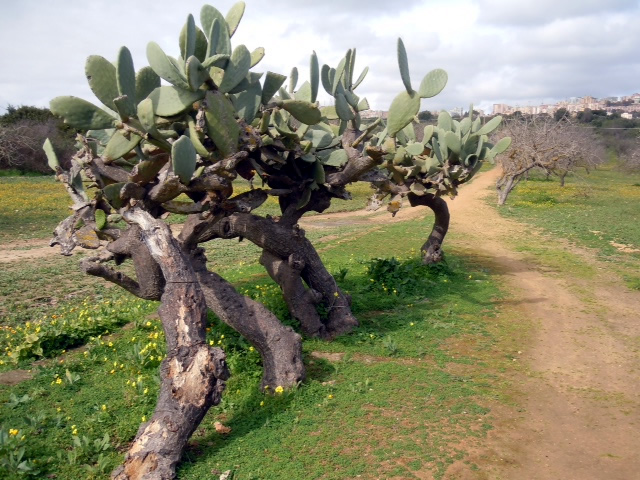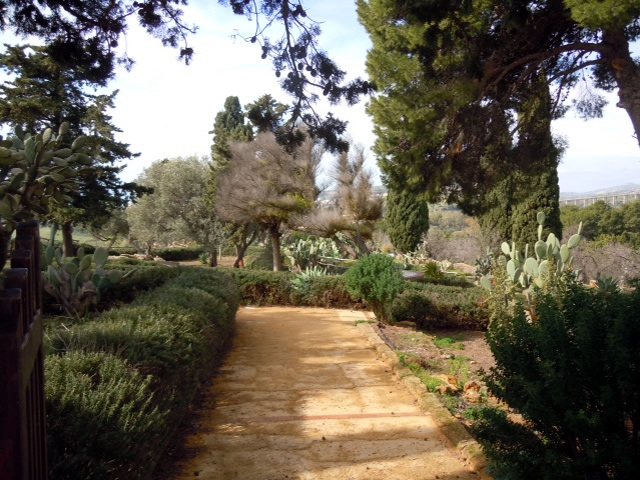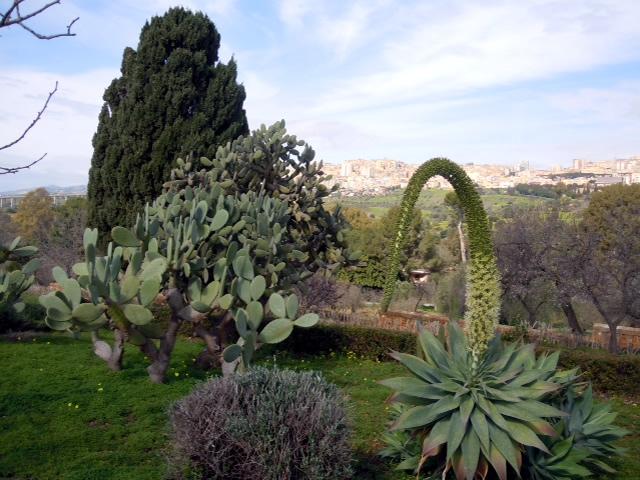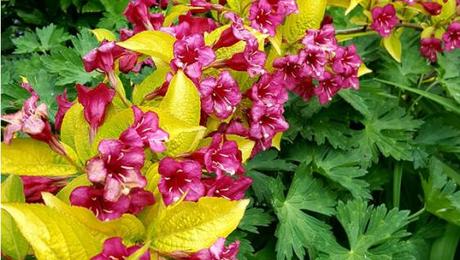
Jan Le Clair and her partner share their experience amongst gardens and temples in Sicily.
"I greet you from south eastern Sicily, where my partner and I are living for a sabbatical. Home is actually southern Ontario Canada, two hours directly north of Syracuse, NY. The snow is a foot deep at home. We travelled to south eastern Sicily last week, up the coast to Agrigento, which is famous for its ancient Greek Temples that are strung across a beautiful valley. In the midst of these temples is a former private garden, now part of the public gardens near the temple ruins. Early spring has arrived in southern Sicily, it is delightful. Enjoy!
Have a garden you'd like to share? Email 5-10 photos and a brief story about your garden to [email protected]. Please include where you are located!
Have a mobile phone? Tag your photos on Instagram or Twitter with #FineGardening!
You don't have to be a professional garden photographer – check out our garden photography tips!
Do you receive the GPOD by email yet? Sign up here.
Follow us: @finegardening on Twitter | FineGardeningMagazine on Facebook | @finegardening on Instagram





Fine Gardening Recommended Products

A.M. Leonard Deluxe Soil Knife & Leather Sheath Combo
Fine Gardening receives a commission for items purchased through links on this site, including Amazon Associates and other affiliate advertising programs.


















Comments
G'day Jan - Sounds like you and your partner are having a lot of fun on your sabbatical. The second and third photos really capture the atmosphere in the garden near the ruins of the temple. Thanks for sharing.
The Prickly Pear certainly has a nice structure, but the plant became a major weed here in Australia. It was introduced in the 19th century and rapidly invaded 15,000 sq. miles of prime agricultural land making it unproductive. In 1925 the Cactoblastis moth was introduced from South America and its larvae did an outstanding job of controlling the plant. It is one of the best examples of successful biological control of a pest anywhere in the world. Sorry for the distraction guys. Cheers from Oz
Hmmm, thanks for the side note, Frank! Very interesting! Cheers from NY with 2 1/2+ feet of snow!
Thanks Margaret. Hope that snow melts soon and you have some nice spring weather. Cheers, Frank
Thanks, Frank for the history. I looked up more information. Evidently it was first attributed to being imported from the British to establish a colony of plants that would produce the red dye used in British military coats. By 1920, the plant was spreading at a rate of 2.4 million acres a year. It again shows the dangers of introducing non-native plants. Great success story for biological control.
Have a great day.
Thanks Kev. Nice research.
Not sure if you like this kind of history, but 'A Perfect Red' by Amy Butler Greenfield is a great look at cochineal in relation to history. I found it fascinating and fits right in with the prickly pear and the scale insect that produces the scarlet dye.
That's fascinating. So many times biological controls have terrible, unintended consequences. Nice to hear of a success!
Yes Tim, we have plenty that haven't worked, but this one is a ripper. Cheers, Frank
Thanks for sharing the fascinating history of Prickly Pear in Australia and the problems it caused. I knew that feral cats (and rabbits) were/are considered major invasive species in Australia (caused the extinction of one of your parrot species [cats not rabbits], I think), but did not realize that Prickly Pear had been an invasive species causing extensive damage also. My two lovely little house-tamed feral cats refuse to put a paw on the ground since they were rescued. Rabbits and Prickly Pears would give them nightmares.
Hey Sonya - Great to hear from you. Sounds like your cats have a good life and are pretty spoilt. Yes we do have a lot of introduced species which have a negative impact on the environment e.g. European carp in our waterways, foxes and cane toads. However, being an island continent isolated from the rest of the world geographically for a long time, there are many exotic diseases and pests we don't have e.g. foot and mouth disease, Dutch Elm Disease. Biosecurity is therefore so important for our country. It is important for market access of our primary products (i.e. international trade), for the international competitiveness of our agricultural and horticultural industries (i.e. lower production costs), and for the recreational value of our parks and gardens etc. - and that is hard to put an economic value on. All I can say though is that gardening is the main recreational activity of 40% of mature adults here i.e. important social value and represents a lot of votes politically. Cheers, Frank
Thanks for the additional history on the prickly pear, Frank. You always have something interesting to add.
Ya'll are doing such much better a job of protecting your environment from invasive species than we are. Hats off to Australia!
Thanks for sharing photos from your trip. (Loved the blossoms, especially!) The ruins make an interesting backdrop for the photos. Is there an orchard in the background of a couple of the photos?
Hi, Jan, thanks for sharing some of your travels with us. I'm wondering if the aloe plants with the wonderful orange flower are as good sized as the perspective of the picture makes them seem to be? They are, no doubt, growing in their climate of origin and have a chance to get large and robust. Has to be a real treat to be enjoying bone fide mild Mediterranean climate when back home is cold and snowy.
Jan, it is always a delight seeing gardens and terrains from other lands. Having only lived in the South, arid gardens are like alien planets to me. Beautiful alien planets. You and your partner must be enjoying your sabbatical in such a lovely part of the world. The agave with the long arching green blossom especially caught my attention. It's even cold here in North GA to (19 degrees F when I awoke) but scheduled to get back to the 70's by Sunday. Enjoy the nice Mediterranean climate. Thanks for sharing.
Wow! Cactus trees and blooming Agave is Sicily. Who knew? Thanks for sharing your photos. My grandfather immigrated to the US from Sicily. I should consider a visit! I hope you have an enjoyable and productive sabbatical.
You must pinch yourself every morning you wake up in sunny Sicily as opposed to your snowy Ontario home! Sicily sounds like the perfect location for a sabbatical, we've never traveled there but from these photos it looks like it needs to be added to our list. Enjoy this amazing adventure!
Good morning Jan and all my GPOD friends! It's one armed Rhonda here! I am still numb from the surgery yesterday so I am able to get on my IPad to check things out! Kev, one of the nurses showed me pics from the flower show. Spectacular! She happened to be from the Netherlands! Frank, I really enjoyed your post this morning. It's great to learn from each other! Now, back to Sicily. I didn't picture all of those succulents. I thought it was all sky rocket junipers! LOL! Jan, thanks for educating me!
Sorry to hear you are suffering, Rhonda and hope you are soon able to swing that arm again.
Gardening by iPad sounds just the right thing to keep you busy and interested.
Thanks Eddi!
Glad you are doing well, Rhonda and one arming it successfully for the time being. I looked up the procedure you had after you mentioned its name yesterday. I suspect it is my future. Perhaps I misinterpreted you but I got the impression that you've already had this done on your other hand? How long do you expect it to be before your hand is fully functioning agin?
Right you are, Michaele. The other hand was 2 years ago and done differently. They gave me a nerve block that lasted 27 hours. Now the pain has arrived. The pain only lasts about 4-5 days, then at two weeks the sutures come out and a splint is made. PT starts in 3-4 weeks, then you are doing fairly well. Complete healing in 9 months to one year. Nothing to complain about compared to my precious sister.
It's humbling to have the perspective of what your sister is dealing with to feel fortunate about your own situation. However, anything that takes a full year to recover from is a fairly big deal. It sounds like you are blessed with a good attitude and a strong spirit.
Hi, one armed Rhonda. Glad to hear you are up and about. You picked a good time to have surgery, since I don't think there will be any gardening here for a while. We are supposed to be below normal temps for a while.
Do you still have the extra ticket? I think Mollie will drive me on Sunday.
I do have an extra ticket. I will text you my train time later.
Hey Rhonda - you just cannot keep a good GPODer down, even though typing one handed would have taken some time! Hope you can make the Flower Show on Sunday.
Me too, Frank. Pretty ouch-y tonight.
Rhonda, hope your recovery is as fast and painless as possible. I anticipate having to do something in the not to distant future (De Quervain's tenosynovitis) iplus arthritis in two fingers. Getting older is not for the wimpy. That said, all gardeners are eternal optimist; always looking to the future for the changing of the season, the new plant, and the arrival of old favorites in our gardens. Keep using the other hand; I've taught myself to be omnidextrous.
What a treat! Thank you.
Jan, what a great place to be able to do a sabbatical. Like others here, I did not expect the terrain to be so arid. It really is the perfect backdrop for the ruins. Thanks for sharing your travels with us.
Thank you Jan for including us in your trip to Sicily. I haven't visited there but did spend some time in the Greek Islands so I am very interested to see that the vegetation is quite different, I had assumed it would be similar. Have a really wonderful sabbatical.
And, as usual the subsequent comments are enlightening and educational - thank you Frank, Jay and Tim for all the information. Being British/American I am now suffering acute guilt that British influence caused such a terrible problem for Oz!
Don't feel too bad about it Eddi - there wouldn't have been white settlement of Oz for a long time if your mother country had not off-loaded some of its convicts in 1788 - and Aussies wouldn't have attitude! Cheers, Frank
Hi, Jan. Great photos. Love the honey bee in the apple? (cherry?) blooms in the fourth photo. I am also partial to aloes as many have such great blooms. It surprised me that there were Greek ruins in Sicily. I had to do a quick search to find out that Sicily had several important Greek colonies and, along with southern Italy, was part of the greater Greek influence (the Magna Graecia as the Romans refered to it) in the Mediterranean in ancient times.
At the opposite end of the spectrum, I had not expected those obviously well established new world cacti and agave as important parts of an old world garden. It's a fairly new phenomenon here to plant these natives in the areas with a summer-dry Mediterranean climate so seeing them half a world away seemed odd. On the other hand, just as no prophet is accepted in his own country, so too do many plants have to travel to be embraced.
What some people still call ditch weeds in the US, were, for example, coveted by the Europeans as new and exotic discoveries. Here, many of our natives were considered too rough and common for our gardens; we preferred plants from Europe or Asia. Our plants had to go Europe and take the grand tour before they were considered refined and respectable enough to plant back home. Goldsturm Daisy (black-eyed Susan), Kobold blazing star, Magnus purple coneflower, most of the Joe-Pye weeds and many others are European selections of American plants that we now use in our gardens every day.
Nice work Chris.
Oops
How beautiful! Sid not realize it was so arid in Sicily. Thank you Chris, Frank and others for all the interesting info. Great background information.
Hey Shirley - has the rain cleared in the Northwest?
Well - yes and no. Today was mostly sunny and in the 40s (F), but the rain is scheduled to return tomorrow. Several rivers are on flood watch.
We are on high ground so it is not personally a worry. Weather news this a.m. said that we - again - received 1 year's worth of rain in the last 5 1/2 months. This is no desert, altho in July and August I may think differently... I have 40 Hellebores blooming, the iris reticulata are blooming, and the daffodils are starting. Spring is trying - at times, very trying! But I'm glad I am not in the northeast - I've had my fill of NE winters. Cheers, Frank.
Thanks for a comprehensive report, Shirley. 90 F here now (2.00 pm on St Patrick's Day). Cheers from Oz
Good afternoon, Jan. Thanks for sharing photos of your trip. I love to see pictures from different areas around the world. I was also surprised with the cacti and agave. The sunshine in the pictures are warming me up, as I look out at the blanket of snow. Enjoy your trip.
I feel warmer just looking at your photos, and am so glad to see the honeybee. Thanks, Jan!
Log in or create an account to post a comment.
Sign up Log in